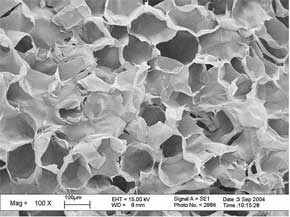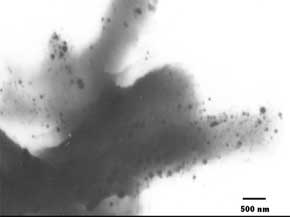| Posted: Jan 18, 2007 | |
Stabilizing antimicrobial nanosilver on a natural porous plant material |
|
| (Nanowerk Spotlight) Silver has long been recognized for its infection-fighting properties and it has a long and intriguing history as an antibiotic in human health care. In ancient Greece and Rome, silver was used to fight infections and control spoilage. | |
| In the late 19th century, the botanist von Nägeli discovered that minute concentrations of silver contained microbiocidal properties. However, as the first antibiotics were discovered, this old household remedy was quickly forgotten. In an alarming trend, bacteria and other microorganisms that cause infections are becoming remarkably resilient and can develop ways to survive drugs meant to kill or weaken them. | |
| This antibiotic resistance is due largely to the increasing use of antibiotics. This led researchers to re-evaluate old antimicrobial substances such as silver. Silver nanoparticles have become the promising antimicrobial material in a variety of applications because they can damage bacterial cells by destroying the enzymes that transport cell nutrient and weakening the cell membrane or cell wall and cytoplasm. | |
| Unfortunately, in practical applications, the pure silver nanoparticles are unstable with respect to agglomeration. In most cases, this aggregation leads to the loss of the properties associated with the nanoscale of metallic particles. The stabilization of metallic colloids and thus the means to preserve their finely dispersed state is a crucial aspect to consider during their applications. | |
| Researchers in China have successfully demonstrated the use of a natural macroporous matrix for fabricating a stable, biocompatible nanocomposite with high silver content for antimicrobial purposes. | |
| The mechanism of inhibitory action of silver on microbes is not quite clear. Some researchers believed that, being treated by silver, the DNA of bacteria loses its replication ability and the enzymes of bacteria that transport cell nutrients are destroyed, and the cell membrane and cytoplasm are also weakened. Some reports show that the incorporation of silver nanoparticles into the cell membrane structure of the micro-organisms may be crucial to the inhibitory function. Whatever the mechanism may be, the potential application of silver nanoparticles in the human body as anti-bacterial materials requires that the preparation process should be facile and cost effective, and that the materials should be safe to the human body. | |
| Due to their solid-state nature and high specific volumes, porous materials have been proved to be promising hosts for nanoparticles. They can not only accommodate high content of nanoparticles, but also endow new or enhanced functions to the nanoparticles. For example, porous carbon-supported platinum nanoparticles can be used as the catalyst for fuel cells, and nanoparticles deposited in mesoporous silica or zirconia may have potential applications in the optical field. | |
| Macroporous materials are abundant in nature and these natural materials can readily serve as cost-effective matrices or substrates for the formation of nanoparticles. Also, more importantly, many of the natural macroporous materials are biodegradable and non-toxic to human beings, thus making them good candidates as matrices or substrates for the formation of nanoparticle composites in biomedical applications. | |
| Chinese researchers used the stem of the rice paper plant (Tetrapanax papyriferus) to form silver nanoparticles through in situ processing. | |
  |
|
| (left) Morphology of the macropores of the rice-paper plant stem; (right) TEM image for silver nanoparticles formed on the rice-paper plant matrix. (Images: Dr. Zeng) | |
| "In our research, we selected a natural macroporous matrix with micron-sized pores and successfully formed silver nanoparticles into it without using any other stabilizer" Dr. Fang Zeng explains to Nanowerk. "For our approach, the micron-sized pores served as compartments for the reduction reaction of silver ions, and the nucleation of silver crystals inside each pore was controlled by optimizing the reaction condition. As a result, silver nanoparticles were obtained on the matrix with high content. Furthermore, this biocompatible nanosilver/matrix composite was found to exhibit high anti-microbial activities for both Escherichia coli and Candida albicans." | |
| Zeng, a scientist at the Research Institute of Materials Science at South China University of Technology in Guangzhou/PR China, together with colleagues from the Guangdong Detection Center for Microbiology, notes that the difficulty for forming nanoparticles in macroporous matrixes with micron-sized pores is that the large pores cannot restrict the size of the resultant particles. Therefore the control of nucleation of silver crystal during the reduction reaction is key to the successful formation of nanosized silver particles onto the matrix. | |
| For their experiment, the researchers reduced the stem of rice-paper plant to clean granules of 1-3 mm in size. The in situ formation of silver nanoparticles onto the porous matrix was carried out through the reduction of silver nitrate (AgNO3) in an aqueous dispersion. The granules were immersed in ethanol for 5 min and then in aqueous solution of sodium borohydride (NaBH4), a water soluble reducing agent, for 20 min. | |
| For the preparation of silver nanoparticles in a mesoporous matrix, the nanosized pores were used as the nanoreactors and particle stabilizers. In their study, Zeng and his colleagues found no nanopores on the walls of the macroporous cellulose matrix. | |
| "The formation of silver nanoparticles in this matrix with micronsized pores, we think, is different from that using mesoporous matrices" he says. "In our study, the macropores played an important role in the formation of silver nanoparticles." | |
| The formation of silver particles involves the nucleation, growth and aggregation process. The unique structure of a macroporous matrix with very high specific surface area could provide a large amount of nucleation sites for silver clusters reduced from silver ions. Thus crystal growth can be controlled by optimizing the amount of AgNO3 charged into the reaction system. On the other hand, the addition of ethanol was also important to the formation of nanosilver. | |
| "We found that, if no ethanol was added into the reaction medium prior to sodium borohydride NaBH4 only particle aggregations with a size of several microns were formed on the matrix" says Zeng. | |
| To evaluate the anti-microbial activity of the nanosilver composites that they prepared, the researchers performed the minimum inhibitory concentration (MIC) assays for the composites against two microbes: the gram-negative bacterium E. coli and the fungi Candida albicans. On the other hand, a comparison test was also performed with the colloidal silver (with an average particle size of 63 nm) stabilized by sodium oleate. | |
| "The results for MIC assays show that the minimum inhibitory concentration for nanosilver composite is of the same order of magnitude as that of colloidal silver" Zeng says. "We also found that the macroporous matrix with no nanosilver could not noticeably inhibit the growth of microbes." | |
| This new method for nanosilver composite formation may be applied to other macroporous materials, especially those with micron-sized pores, as long as there are functional groups inside the macropores which can provide interactions with the nanoparticle precursors, such as silver ions. | |
| These findings have been reported in Nanotechnology "Silver nanoparticles directly formed on natural macroporous matrix and their anti-microbial activities". | |
 By
Michael
Berger
– Michael is author of three books by the Royal Society of Chemistry:
Nano-Society: Pushing the Boundaries of Technology,
Nanotechnology: The Future is Tiny, and
Nanoengineering: The Skills and Tools Making Technology Invisible
Copyright ©
Nanowerk LLC
By
Michael
Berger
– Michael is author of three books by the Royal Society of Chemistry:
Nano-Society: Pushing the Boundaries of Technology,
Nanotechnology: The Future is Tiny, and
Nanoengineering: The Skills and Tools Making Technology Invisible
Copyright ©
Nanowerk LLC
|
Become a Spotlight guest author! Join our large and growing group of guest contributors. Have you just published a scientific paper or have other exciting developments to share with the nanotechnology community? Here is how to publish on nanowerk.com.
